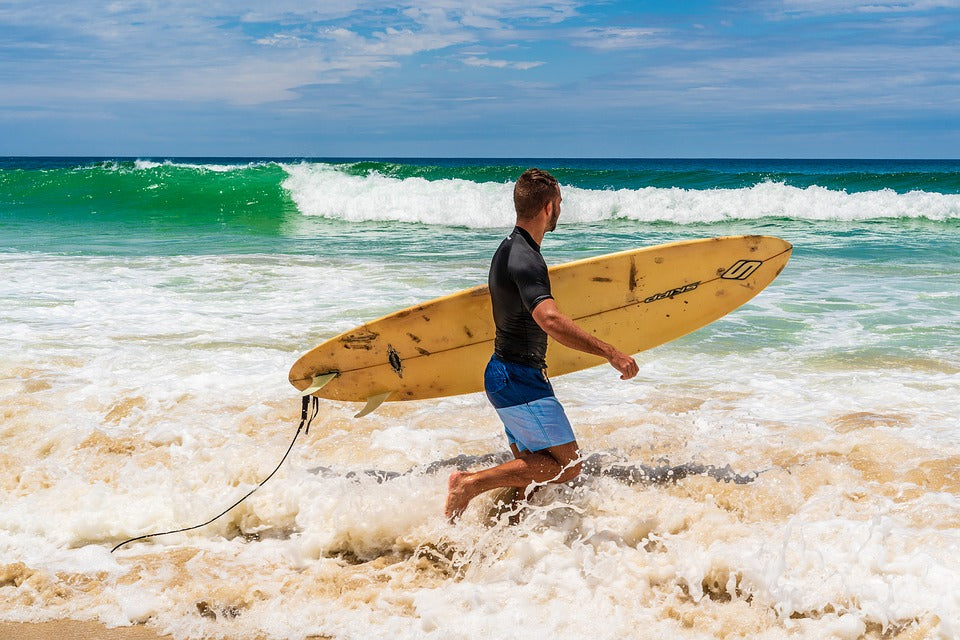Surfboards have been around from at least 1777 when the first recorded document of surfboard usage was written by James Cook. A lot of time has passed since then, and new trends formed, both in design and art. During the 20th century, surfboard culture experienced a huge boom. At that time, the surf culture became mainstream. New surfboard brands started popping up, trying to get to their slice of the cake. The history of surfboard branding started at that time.
Today, there is a huge number of different surfboard brands, it's overwhelming. But, how did the surfboard branding evolve during the last 50 years? Let's find out the key players in the history of surfboard branding in the last 50 years!
The 1950s - The Evolution in Surfboard Branding
The 1950s were a very important decade for surfing culture. George Downing produced the first surfboard for hitting the big waves. This resulted in an evolution in surfboard branding and design.
At this time, the surfing culture crossed into mainstream culture. Surfing culture can give a huge thanks to the movie Gidget for that status.
Numerous surfboard brands started popping up, most notably Hap Jacops, Gordon and Smith and Harbour. The competition started increasing every day, so there was a need to perfect the brand logos on the surfboards.
The 1960s - The Bloom of Surfboard Art

The year 1960 was a very important one for surfboard branding. It was the year when Surfer Magazine started with its press. This magazine started promoting innovative surfboard design, art, and branding. It runs to this day, serving the same purpose.
1960s are most notable for the history of surfboard branding because the artistic part started showing its real colors. There were many crossovers between painters and surfboard publishers. Surfboard art was made by a group of painters and sculptors from Los Angeles, with Ferus Gallery as the main representative. These painters showed how surfboard design can be combined with other spheres of design, like branding.
At this time, new opportunities for surfboard design popped up. New materials such as plastic, resins and other polymer materials were adopted by the surfing culture.
Rick Griffin showed up on the surfboard design and branding scene at this time. He was a poster designer and comic book artist most known for his highly detailed illustrations and surrealistic style. The main character of his surfboard designs was Murphy, who was in more psychedelic situations as designs evolved. Rick Griffin is considered to be the father of present-day surfboard branding. His style was adopted by many newcomer artists.
The 1970s - The Rise of Surfboard Demand
The most notable people when talking about the evolution of surfboard branding in the 1970s are Gerry Lopez and Jack Shipley. They started the Lightning Bolt branded surfboards. The main detail of these surfboards were lightning bolts. This design caused a worldwide sensation and the increase in interest for branded surfboards.
The 1980s - The Fierce Competition Arrives

The 1980s just further increased the interest in branded surfboards. There was more demand for them, and the prices were getting up. More and more different brands started popping up, and the competition was fierce. One of the key surfboard brands during the 1980s was Channel Islands Surfboards.
The 1990s - The Resurgence of the Longboard Surfboard

The 1990s were most notable for the reappearance of longboard surfboards, which lost their popularity in the 1960s. During this period, over 50% of total surfboards on the market were of this design. One of the key players in this period was the Momentum Generation brand.
In 1994, Computer-Aided Design and Computer-Aided Manufacturing underwent key development. This technology allowed for the creation of computer-designed surfboards and branding. It allows more precise and streamlined manufacturing process, adding automation and saving money for the surfboard manufacturers.
The 2000s to Present Day - Alternative Surfboard Branding and Production

The 2000s shed so much light on the rising ecological problems, and that translated to surfboard design and branding. In 2006, an alternative surfboard brand, Firewire, popped up. They are most known for their innovative use of materials, utilizing eco-friendly material such as wood. Actually, during this period, the acceptance of wood material started to grow.
During the same year, Varial Surf Technology was created. This is an advanced composite technology that brings the surfboard performance to the next level.
In 2007, Global Surf Industries showed up with their iconic, hourglass-shaped surfboards.
Fast forward to 2012, Firewire is a global player based in California. They partnered with Daniel Thomson, an Australian shaper. New sub-labels soon started showing up, and a new line of unconventional boards too. The most notable of them is the Vader and the Evo.
Well, that would be all that you have to know about the history of surfboard branding in the last 50 years. As the competition increases with demand, it is most likely that the surfboard branding will undergo many changes during the next decades.
If you want to design a surfboard, we can design it for you with no charge! Just contact us and we will think of something!
If you’re interested to find out more information about branded surfboards, drop us a message with your questions or simply talk with one of us via live chat.
Looking for more interesting content?

